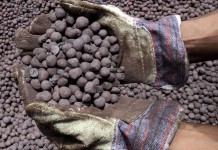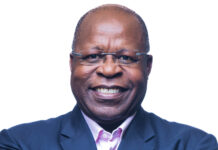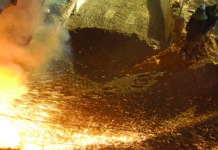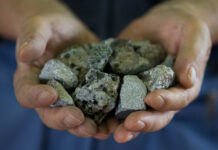
[miningmx.com] – CHEAP steel, properly described as a development steel pricing policy, has been a hobby-horse of the South African government. So it’s a surprise to hear the state’s vassal, the Industrial Development Corporation (IDC), has other things on its mine with its R3.4bn acquisition of the Scaw Metals Group than supplying the market with slabs and rolls of cut-price shiny stuff.
According to Abel Malinga, the IDC’s divisional executive of mining and manufacturing, the purpose of buying Scaw is not to supplant the much-criticised ArcelorMittal South Africa (Amsa) as SA’s primary steel supplier, notwithstanding criticisms the Luxembourg company has been pulling the ring out of SA’s domestic steel market for years – refuted by Amsa -, but to provide momentum to the South African government’s industrialisation strategy.
Scaw produces flat steel products, but the primary aim of production is to secure raw material for its own steel rope manufacturing which it then sells to the mining sector. It also makes chains, and wires, and strand, and a host of other equally unglamorous but no less essential industrial items.
The asset comes to the IDC from Anglo American which sold its 74% controlling stake in Scaw Metals as part of its commitment to ridding itself of non-core assets. Thrown into the bargain is Scaw Metals’s empowerment partners including Shanduka Group. It, and two other black-owned companies, comprise the investment consortium holding 21% with the balance of the shares to be held in an employee share ownership programme, or Esop.
That must virtually, and somewhat neatly, complete Anglo’s divestment programme which the departing CEO, Cynthia Carroll, was appointed to manage. For Malinga, the purchase was a defensive tactic; the IDC didn’t want Scaw being hived off to an international bidder which may have asset stripped the company, he says.
“It’s a Level 4 beneficiator; and it takes tonnes a year of metal and turns it into a final product,’ says Malinga. About 90% of earnings is from its mining products and, as a result, doesn’t have the vulnerability to cycles that seems to affect Amsa so frequently.
Still, if this isn’t the government’s positioning on a development pricing policy, then what’s its strategy in respect of the IDC’s other ferrous metals investments which include a 7.9% stake in Amsa, and a more contentious 50% plus one share stake in Consolidated Wire Industries; contentious because CWI and Scaw control the South African wire market?
The IDC is also a 10% shareholder in Kalahari Resources which has built a manganese mine in the Northern Cape province, a sinter plant, and has ambitions to construct a big ticket manganese smelter at Coega, in the Eastern Cape. Manganese, incidentally, is an important steel feed product.
Malinga says the attraction is influence in the employment and returns of beneficiated products. “We don’t just want to produce manganese but to produce a downstream product from it,’ says Malinga of the investment in Kalahari Resources.
Malinga says the smelter is no slam dunk, however, partly because electricity costs could make it unviable. “We have done a prefeasibility on a smelter, but we’re waiting for a bankable document,’ he says. “We need to finish this and for it to be indicated as viable, or not. If not, can we use technology that is more energy efficient,’ he says.
Kalahari Resources has became embroiled in a dispute with ArcelorMittal [in Luxembourg, not the SA unit] in which the former was accused of corporate governance abuses. ArcelorMittal was a joint venture partner in Kalagadi Manganese with Kalahari Resources until Daphne Mashile-Nkosi, CEO of Kalahari Resources, offered to buy steelmaker’s stake in the business.
Quite how Kalahari Resources, which has already committed tens of millions of rands in capital to building the manganese mine and sinter plant, is to pay for the stake, and follow its rights in future capital calls, is not yet known. One market source says Mashile-Nkosi has no option but to turn to the IDC which will further entrench its exposure to ferrous metals.
Malinga says the IDC has not yet received an offer from Kalahari Resources. “We have had a meeting,’ he says. “We have pre-emptive rights over changes in control, but we have not decided whether to exercise those rights,’ he says.
Lest we forget, the South African government has has its eyes on another steel feed company, Kumba Iron Ore, as per the government-backed study, the State Intervention in Mining (Sims). It has recommended the IDC, in addition to possibly becoming the host to all of Government’s mining investments, to somehow take a larger stake in Kumba Iron Ore in which Anglo has a near-80% stake.
Finweek











